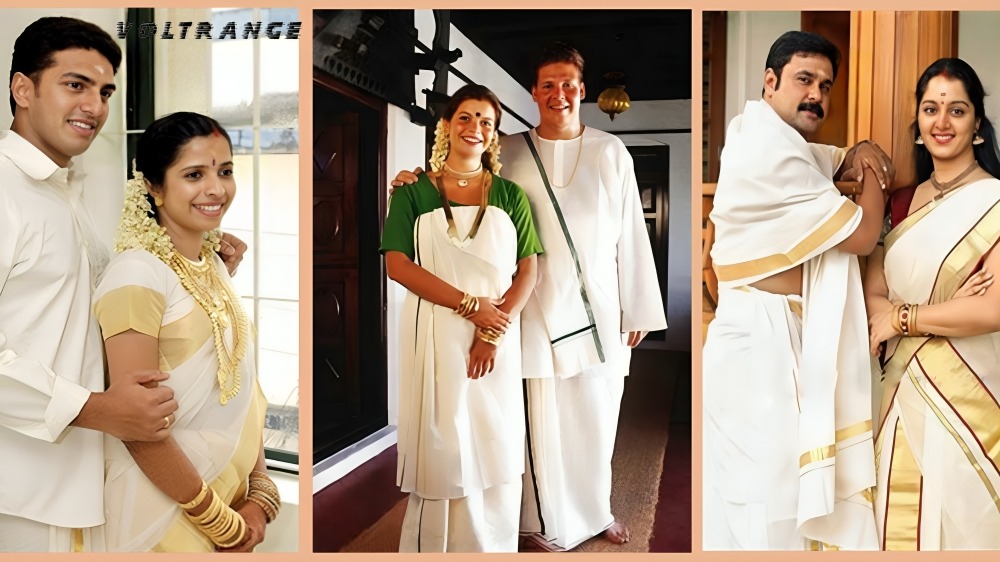
Traditional Dress of Kerala
Traditional Dress of Kerala: Kerala, often referred to as “God’s Own Country,” is a land of stunning natural beauty, rich cultural heritage, and warm, welcoming people. One of the first things you’ll notice when you visit Kerala is the traditional attire worn by the locals. Rooted deeply in history and cultural pride, the traditional dress of Kerala reflects simplicity, elegance, and practicality. Today, we’ll take a closer look at the traditional dress of Kerala for both men and women and explore why these outfits hold such a special place in the heart of the state.
Traditional Dress for Men in Kerala
1. Mundu
The Mundu is the quintessential traditional attire for men in Kerala. It is a long piece of cloth, typically white or cream in color, worn from the waist down to the ankles. This garment is simple but deeply significant in Kerala’s cultural context. The mundu is seen as a symbol of purity and tradition. One of its distinctive features is the border, known as the Kara, which is usually golden. However, the Kara can also be found in other colors for special occasions, such as weddings or festivals, adding a touch of elegance. Traditional Dress of Kerala
The mundu is designed for comfort and practicality. It is often worn loosely around the waist and can be folded up to knee-length for ease of movement, especially when engaging in physical activities or on a warm day. This versatility makes it a popular choice for both daily wear and formal occasions.
2. Jubba
Another important traditional item in men’s clothing is the Jubba, a long shirt that is typically made from silk. Men wear the Jubba as an upper garment, especially during religious or festive events. Sometimes, the Jubba is adorned with intricate patterns or embellishments, making it a beautiful complement to the simplicity of the mundu. During significant occasions, such as weddings, men often wear more ornate versions of the Jubba, showcasing Kerala’s rich cultural heritage.
Traditional Dress for Women in Kerala
1. Mundum-Neriyathum
For women, the Mundum-Neriyathum is a traditional two-piece garment that resembles a saree but has its own distinct style. This attire consists of two parts: the Mundu, worn from the waist down, and the Neriyathum, a piece of cloth draped over the blouse and left shoulder, similar to a saree’s pallu. Generally, the Mundum-Neriyathum is white or cream in color with a golden or colored border, reflecting the understated elegance of Kerala’s traditional fashion. Traditional Dress of Kerala
While the Mundum-Neriyathum is often worn as everyday attire, it is also a staple at festivals, weddings, and other cultural events. The fabric typically varies, with cotton being the preferred material for daily wear in Kerala’s humid climate, while silk is reserved for formal and festive occasions, giving the attire a luxurious appearance.
2. Kerala Saree (Set Mundu)
The Kerala Saree, also known as Set Mundu, is another traditional outfit worn by women, especially during festivals like Onam and Vishu, and for special ceremonies such as weddings. Although similar to the Mundum-Neriyathum in terms of color and design, the Set Mundu is draped in the same style as a saree, providing a different aesthetic. This attire, known for its sophistication and grace, is a representation of Kerala’s cultural pride and is often paired with gold jewelry to complete the look.
Accessories and Jewelry
No traditional Kerala outfit is complete without accessories, especially for women. Temple jewelry, a unique style of ornamentation in Kerala, often features intricate designs of gods and nature motifs. Made from gold, these pieces include necklaces, earrings, and bangles and are worn on special occasions to enhance the beauty of the traditional attire. Traditional Dress of Kerala
For men, the accessories are simpler. The Melmundu, a gold-bordered towel draped over the shoulder, is commonly worn during formal events or ceremonies, further adding to the cultural significance of their attire.
Conclusion
Kerala’s traditional dress is much more than just clothing—it is a reflection of the state’s rich heritage and cultural pride. From the Mundu worn by men to the Mundum-Neriyathum and Kerala Saree adorned by women, these outfits offer a glimpse into the deep-rooted traditions of Kerala. Whether you’re a visitor wanting to experience Kerala’s culture or a local, embracing these traditional attires is a wonderful way to connect with the vibrant legacy of the region. Traditional Dress of Kerala
FAQs about Traditional Dress of Kerala
What is the significance of the Mundu in Kerala’s traditional attire?
The Mundu is a key element of Kerala’s traditional clothing, symbolizing simplicity and purity. Its versatility makes it suitable for both casual wear and formal occasions, with different borders (Kara) used to reflect the significance of the event.
How does the Kerala Saree differ from the Mundum-Neriyathum?
The Kerala Saree (Set Mundu) is similar to the Mundum-Neriyathum but is draped like a saree, giving it a distinct look. It is often worn during festivals and weddings, whereas the Mundum-Neriyathum is more commonly used for daily wear.
What role does jewelry play in traditional Kerala attire?
Jewelry, especially temple jewelry, is an important part of traditional Kerala attire, particularly for women. These gold pieces often feature intricate designs and are worn during special occasions to enhance the traditional look.
Why is the Jubba worn on special occasions?
The Jubba is often worn on special occasions due to its luxurious material, typically silk, and its potential for embellishment with intricate patterns or stones, making it a more festive garment.
Is the Mundu comfortable for everyday wear in Kerala’s climate?
Yes, the Mundu is designed to be loose and airy, making it ideal for Kerala’s warm and humid climate. Its flexibility, which allows it to be adjusted for comfort, is one of the reasons it remains a popular choice for daily wear.





More Stories
Is Sansui an Indian Company? True Or Not
Handles Salary Revision and Appraisal: 10 Fact
Is Walmart an Indian Company? True Or Not